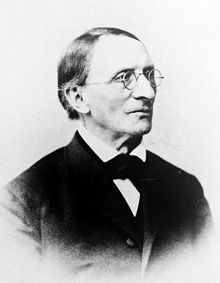Carl Ludwig
Carl Ludwig ForMemRS | |
|---|---|
 | |
| Born | Carl Friedrich Wilhelm Ludwig 29 December 1816 |
| Died | 23 April 1895 (aged 78) |
| Known for | Ludwig–Soret effect Kymograph |
| Awards | Copley Medal (1884) ForMemRS (1875) |
| Scientific career | |
| Fields | Physiology |
Carl Friedrich Wilhelm Ludwig (German:
In 1842, Ludwig became a professor of physiology and in 1846 of
Since 1932, the Carl Ludwig Honorary Medal is awarded by the German Society for Cardiology to outstanding investigators in the area of cardiovascular research.
Life
Ludwig was born at
In 1865 Ludwig was appointed to the newly created chair of physiology at
Appraisal

Ludwig's name is prominent in the history of physiology, and he had a large share in bringing about the change in the method of that science that took place in the middle of the 19th century. With his friends
This point of view was expressed in Ludwig's celebrated Text-book of Human Physiology (1852–1856), but it is as evident in his earliest paper (1842) on the process of urinary secretion as in all his subsequent work. Ludwig exercised enormous influence on the progress of physiology, not only by the discoveries he made, but also by the new methods and apparatus he introduced to its service. Thus, in regard to secretion, he showed that secretory glands, such as the
Ludwig demonstrated the existence of a new class of secretory nerves that control this action, and by showing that if the nerves are appropriately stimulated the salivary glands continue to secrete, even though the animal be decapitated, he initiated the method of experimenting with excised organs. He devised the kymograph as a means of obtaining a written record of the variations in the pressure of the blood in the blood vessels; and this apparatus not only conducted him to many important conclusions respecting the mechanics of the circulation, but afforded the first instance of the use of the graphic method in physiological inquiries. For researches on blood gases, he designed the mercurial blood-pump that, with various modifications, has come into extensive use. He used it for many investigations into gases of the lymph, the gaseous interchanges in living muscle, the significance of oxidized material in the blood, etc.[2]
There is indeed scarcely any branch of physiology, except the physiology of the senses, to which Ludwig did not make important contributions. He was also a great power as a teacher and the founder of a school. Under him the Physiological Institute at Leipzig became an organized center of physiological research, whence issued a steady stream of original work; and though the papers containing the results usually bore the name of his pupils only, every investigation was inspired by him and carried out under his personal direction. Thus, his pupils gained a practical acquaintance with his methods and ways of thought, and, coming from all parts of Europe, they returned to their own countries to spread and extend his doctrines. Possessed himself of extraordinary manipulative skill, he abhorred rough and clumsy work, and he insisted that experiments on animals should be planned and prepared with the utmost care, not only to avoid the infliction of pain (which was also guarded against by the use of an anesthetic), but to ensure that the deductions drawn from them should have their full scientific value. [2]
Notes
- ^ Current website of the Carl-Ludwig-Institute of Physiology http://cliphys.uniklinikum-leipzig.de/
- ^ a b c d e f Chisholm 1911, p. 114.
References
- Attribution
- This article incorporates text from a publication now in the public domain: Chisholm, Hugh, ed. (1911). "Ludwig, Karl Friedrich Wilhelm". Encyclopædia Britannica. Vol. 17 (11th ed.). Cambridge University Press. p. 114.
Further reading
- Luderitz B.: Carl Friedrich Wilhelm Ludwig (1816–1895). – Source Journal of Interventional Cardiac Electrophysiology 2004 Dec;11(3):221-2. PMID 15548890
- Zimmer HG.: The contributions of Carl Ludwig to cardiology. Can. J. Cardiol. 1999 Mar;15(3):323-9. PMID 10202196
- PMID 8671870
- Schubert E.: The theory of and experimentation into respiratory gas exchange—Carl Ludwig and his school. PMID 8994552
- Seller H.: Carl Ludwig and the localization of the medullary vasomotor center: old and new concepts of the generation of sympathetic tone. Pflügers Arch. 1996;432(3 Suppl):R94-8. PMID 8994549
- Thurau K, Davis JM, Haberle DA.: Carl Friedrich Wilhelm Ludwig: the founder of modern renal physiology. Pflügers Arch. 1996;432(3 Suppl):R68-72. PMID 8994545
- Schröer H.: Relevance and reliability of Ludwig's scientific conceptions of the physiology of the microcirculation. Pflügers Arch. 1996;432(3 Suppl):R23-32. PMID 8994539
- Zimmer HG.: Carl Ludwig: the man, his time, his influence. Pflügers Arch. 1996;432(3 Suppl):R9-22. PMID 8994538
- Ludwig CF.: 1842—a landmark in nephrology: Carl Ludwig's revolutionary concept of renal function. Kidney Int(ernational). Suppl. 1994 Oct;46:1–23. PMID 7823448
- PMID 2032415
- Fye WB.: Carl Ludwig and the Leipzig Physiological Institute: 'a factory of new knowledge'. Circulation. 1986 Nov;74(5):920-8. PMID 3533314
